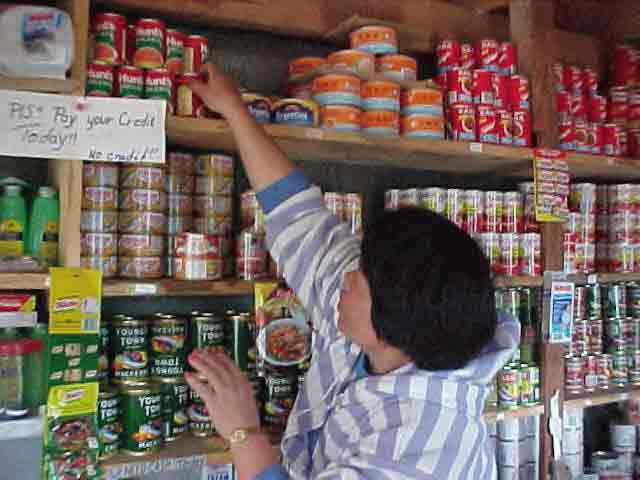|
Sari-Sari Stores Considering the mercantile attitudes and sales abilities of the Filipinos the publicist Regalario wrote once: Give a Filipino thousand pesos and he probably will use this sum as a start-capital for a small retail-business". This thesis seems to be confirmed, if you look in a typical street of a Philippine barangay. With few exceptions one sari-sari store follows the other. You could gain the impression, that every house is or has a little street store - the Philippines as an agglomeration of small and smallest micro enterprises. The ubiquitous sari-sari stores are also belonging to the typical inventory of the Philippines like the Jeepney, Barong or the Sampaguita garlands. They can provide the owners with an additional income.
Sari-saris have an important social function in everyday life. Here you can hear the newest gossips and you can have a little chat. In the morning you see perhaps women with their children, clinging on the apron strings and pleading for sweeties. Later the pupils come for a Coke or a comic strip. And in the evening men can sit on provisory benches smoking cigarettes or drinking beer and Ginebra, just to forget the frustration of the day or to have some entertainment. With closing time the store gets very well secured, because you never know
But what a misery there are always poor blighters asking for a credit. Now the owner is confronted with a sleep robbing problem: Should I give credits, and if so - to whom, which amount, in which time? Many owners try to evade this questions by demonstratively putting up a information board No Credit!. But if they give no credits, they may loose buyers and if they give to much, the debtor may not come again. But despite of all information boards, most sari-sari shops - especially on the country side - operate as little creditors. The Nielsen Company (1) estimated for the year 2000, that there are round about 430 000 sari-sari stores on the Philippines. If this number is nearly exact, it would mean that there is one sari-sari store on 26 households. Even in the business and administration quarter of Makati there have been counted 3500 sari- sari stores in 1997. But we should be sceptical about the data. The NSO-Census (2) counted in 1975 nearly 750.000 sari-sari stores, but this number decreased to miraculous 100 000 in 1996. One reason for this confusion of numbers can be, that sari-saris are still partly belonging to the grey market or underground economy despite a forced notification pressure by the authorities responsible for registration and taxation. In 1996 there was a report, that the unofficial GNP was estimated 30 40 % higher than the official GNP. A shop which is not registered has a chance to evade fees and taxes. From 1994 we have a statistic showing that the sari-sari stores represent about eighty per cent of the retail outlets, but they took in cash only 12.4% of the consumption expenditures. About half of the consumption expenditure have been allotted to the Supermarkets. The above mentioned Nielsen data delivers also the information, that from 1997 to 2000 the number of sari-sari stores increased by 88 %. Thats quite astonishing. In western countries we have a strong decline of corner shops in favour of chains of supermarkets. And these data are also contrary to some assertions speaking from a decline of sari-sari-shops. There are good reasons for the assumption that considering especially the higher mobility and higher household incomes of the population - the larger and more attractive shopping malls, supermarkets and department stores in the towns would play their special trump play of having price and offer advantages and that they would remove the customers from the sari-saris stores. Why it is not like this in the data, seems to belong to the hoard of inexplicable secrets of the statistics. © Wolfgang Bethge, in 2003
(1) quoted after: Gladys de Veyra, AC Nielsen Philippines, The Filipino Retail Trade in the Midst of global Changes, www.ecrphils.com/2nd%20ECR%20Conference/DAY_1/Phil_Retail_Trade1.PDF (2) quoted after: The Economist Newspaper, 1996, Retailing in The Philippines, http://huaren.org/diaspora/asia/philippines/doc/042298th.html |
 Sari-sari
stores are often little wooden huts. A oversized billboard, emphasizing
the importance
Sari-sari
stores are often little wooden huts. A oversized billboard, emphasizing
the importance